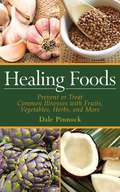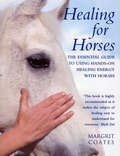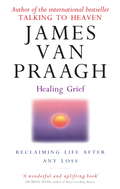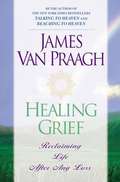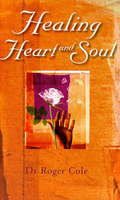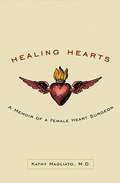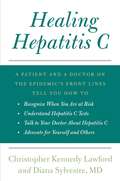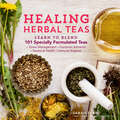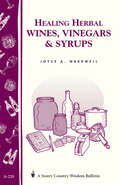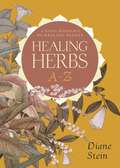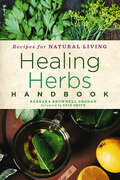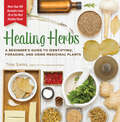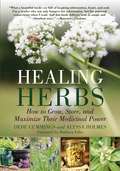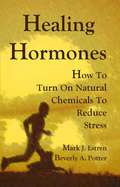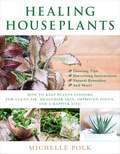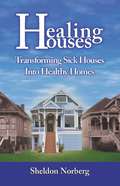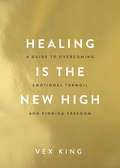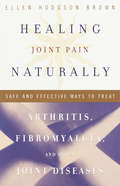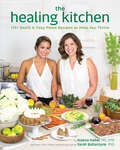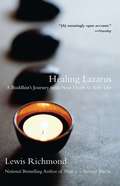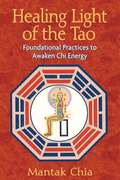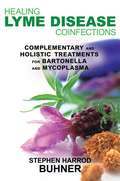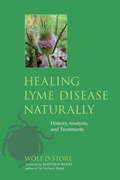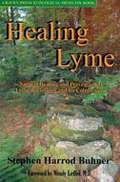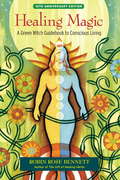- Table View
- List View
Healing Foods: Prevent and Treat Common Illnesses with Fruits, Vegetables, Herbs, and More
by Dale PinnockIn Healing Foods, author Dale Pinnock explains how the healing power of foods stretches beyond the realm of vitamins and minerals to involve a far more complex and wondrous group of biological compounds-phytochemicals! Pinnock shows readers how many of these compounds, when properly delivered, can work as well as medicinal plants and even pharmaceutical drugs without the risk of side effects. Pinnock explains how to prepare dishes that are not only delicious, but also possess a powerful medicinal property. Think classic carrot and ginger soup, digestive tonic tea, dandelion salad, and more! Complete with an A-Z guide to common medicinal foods, Healing Foods is your one-stop reference for remedying health woes through the power of food.
Healing For Horses
by Margrit CoatesHealing for Horses is the most comprehensive guide available on the subject of using healing energy with horses. In this book, the world’s leading animal healer, explains what healing is, how it works and how it helps in the context of horses. Margrit Coates gives practical guidance on how you can learn the skill yourself, when and where to do it, together with 'dos and don'ts'. Margrit also describes the way energy runs through a living being, what and where the chakras are on horses, and how healing can benefit horses and improve the horse-human bond. Included are many fascinating case histories of horses who have been sick, depressed, injured, traumatised or terminally ill, with detailed descriptions of how healing has helped them all. Packed full of tips, photos, illustrations and guidelines, Healing for Horses is an essential book for every horse lover, as well as those of us who work with horses in any capacity way.
Healing Grief: Reclaiming Life After Any Loss
by James van PraaghIn HEALING GRIEF James Van Praagh draws on his unique access to the world of spirit to show you how to move on from pain and grief to achieve inner peace.Sensitive and inspiring, HEALING GRIEF shows you how to cope with losing a loved one and rebuilding your life. The book explains that by confronting repressed feelings of grief and anger you can bring about self-healing. Through James Van Praagh's advice and guidance you may begin to recognise your loss, beyond the pain and sadness it brings, as an opportunity to involve yourself fully in life. HEALING GRIEF also explores other kinds of loss including divorce, losing your home or job and ageing.
Healing Grief: Reclaiming life after any loss
by James Van Praagh"Grieving is a natural process. It is through our losses that we can transform ourselves and find new meaning in life." --James Van Praagh James Van Praagh, who possesses the extraordinary ability to communicate with the heavenly realm beyond our physical world, has changed the lives of millions of people who have lost loved ones. Now, in a book destined to open pathways of hope and healing for millions more, the renowned medium and author of the New York Times bestsellers Talking to Heaven and Reaching to Heaven reveals how the devastating sorrow of a loss can lead to incredible opportunities for spiritual growth--and bring a sense of renewal and focus to our lives. Van Praagh shares many insightful spiritual messages from deceased loved ones, who shed new light on grief and loss. These stories, along with accounts of his own personal experiences, assist us in viewing our losses as stepping-stones on our soul's evolving spiritual journey. In turn, we become aware of how we are connected to a larger universe, between the seen and unseen worlds. This deeply felt, wise, and compassionate book offers hope for a true healing of the mind and spirit, as we move beyond grief and loss--to a life of freedom, joy, and purpose.
Healing Heart and Soul
by Roger ColeCan you mend a broken heart and begin to love again? Can you remain calm in an ever-changing world? Discover who you really are ? a peaceful soul ? and what your true purpose in life is.We all experience grief, loss or sadness at some time in our lives. Through spiritual lessons, meditations and affirmations, Healing Heart and Soul teaches us how to mend a broken heart, overcome our vulnerability to loss and experience deep and lasting love. When we understand that the soul, mind, heart and intellect are intimately entwined, we begin to heal ourselves and others. Through divine love we develop our healing power and become living angels who extend this healing to the world. DR ROGER COLE is an oncologist and palliative care physician and has been caring for the terminally ill for many years. He has published articles on palliative care, meditation for health professionals and the spiritual care of the dying. He is also the author of the bestselling book MISSION OF LOVE.
Healing Hearts: A Memoir of a Female Heart Surgeon
by Kathy E. MagliatoAn inspiring, surprising, sometimes shocking, and ultimately deeply informative memoir of the high-stakes, high-pressured life of a female heart surgeon Dr. Kathy Magliato is one of the few female heart surgeons practicing in the world today. She is also a member of an even more exclusive group--those surgeons specially trained to perform heart transplants. Healing Hearts is the story of the making of a surgeon who is also a wife and mother. Dr. Magliato takes us into her highly demanding, physically intense, male-dominated world and shows us how she masterfully works to save patients' lives every day. In her memoir, we come to know many of those patients whose lives Dr. Magliato has touched: a baby born with a hole in her heart, a ninety-four-year-old woman with a lethal tear in her aorta, and a thirty-five-year-old movie producer who saves her own life by recognizing the symptoms of a heart attack. Along the way, Dr. Magliato sheds light on the too often unrecognized symptoms of a heart attack and cardiovascular disease--the number one killer of women in America--and the specific measures that can be taken to prevent it. As we begin to see what it takes for Dr. Magliato to heal hearts day after day, we come to understand a more human side of the medical profession. Dr. Magliato celebrates with her patients when they overcome their disease and personally mourns when they die as a result of it. She understands deeply the pain and suffering that heart disease can wreak on patients as well as on their families. Healing Hearts is not only her story, it is also the story of everyone affected by heart disease--roughly one in three Americans.
Healing Hepatitis C
by Christopher Kennedy Lawford Diana SylvestreGet the facts about Hepatitis C Having hepatitis C can be a transformative, extremely tough experience--especially without the right information. Healing Hepatitis C remedies that by combining the personal story of Christopher Kennedy Lawford, who unknowingly contracted the virus during his years of drug use, with the medical expertise of Dr. Diana Sylvestre, who has devoted her career to treating hepatitis C sufferers. Together they deal with the stigma and misinformation, and the fears and frustrations of this illness. Healing Hepatitis C serves as a valuable sourcebook for medical and treatment information: from what hepatitis C is to what it does, and from what to expect during treatment to how to communicate with your physician, to finding the support you need. Most of all, it walks you through the process of facing the diagnosis and treatment head-on, showing you that it is possible to get through hepatitis C--to be cured of it--without surrendering your life to it. Together Lawford and Sylvestre offer hope, humor, and medical expertise to help patients, their friends, and families navigate the numerous challenges of hepatitis C virus education, testing, and treatment.
Healing Herbal Teas: Learn to Blend 101 Specially Formulated Teas for Stress Management, Common Ailments, Seasonal Health, and Immune Support
by Sarah FarrFreshly blended herbal teas offer more healing power than do pre-packaged tea bags. In Healing Herbal Teas, master herbalist and author Sarah Farr serves up 101 original recipes that not only offer health advantages but also taste great. Formulations to benefit each body system and promote well-being include Daily Adrenal Support, Inflammation Reduction, and Digestive Tonic. Additional recipes that address seasonal needs such as allergy relief or immune support will attune you to the cycles of nature, while instruction on the art of tea blending will teach you how to develop your own signature mixtures to give your body exactly what it needs. This book is an enchanting and delectable guide to blending and brewing power-packed herbal teas at home.
Healing Herbal Wines, Vinegars & Syrups: Storey Country Wisdom Bulletin A-228 (Storey Country Wisdom Bulletin Ser.)
by Joyce A. WardwellSince 1973, Storey's Country Wisdom Bulletins have offered practical, hands-on instructions designed to help readers master dozens of country living skills quickly and easily. There are now more than 170 titles in this series, and their remarkable popularity reflects the common desire of country and city dwellers alike to cultivate personal independence in everyday life.
Healing Herbs A to Z: A Handy Reference to Healing Plants
by Diane SteinAn alphabetical quick reference to 200 medicinal plants, their special healing attributes, most effective applications, potential side effects, and contraindications.The popularity of commercially available herbal remedies as adjuncts to conventional medicines has made it easier than ever to turn to medicinal herbs. Stein shares her extensive knowledge and experience with healing botanicals in this quick reference. Each entry includes an accessible and detailed resume of each plant's specific healing properties.
Healing Herbs Handbook: Recipes for Natural Living (Recipes for Natural Living #3)
by Barbara Brownell GroganNaturally Healthy Today, more and more people are trying to live healthily and fight illness without resorting to the pharmacy—and they are turning to herbs to achieve their goal. This approachable handbook, with photographs for easy identification, helps you understand and take best advantage of herbal medicine. It first offers a brief introduction to the basics—such as choosing, growing, and preparing herbs. Then you will find descriptions of 60 herbs and what to use them for, and then 60 ailments that herbs can be used to treat, along with handy recipes. Authoritative and easy to use, Healing Herbs Handbook is your one-stop guide to herbal health.
Healing Herbs: A Beginner's Guide to Identifying, Foraging, and Using Medicinal Plants
by Tina Sams“Guides you step by step through the how and why of medicinal herbs in a down to earth and experienced manner.” —Susanna Reppert Brill, The Rosemary House, Mechanicsburg, PAEver wondered about the benefits of dandelion, chickweed, and elder? Healing Herbs is an essential reference for the beginning herbalist, featuring 20 common herbs, many of which are considered weeds, that can often be found in hedgerows, meadows, and wild places.Along with medicinal information, this book includes traditional folklore and fortifying recipes for each edible or medicinal plant, and plenty of easy-to-follow instructions to help fill a backyard herbalist’s medicine chest with remedies to keep the whole family happy and healthy.Healing Herbs is conveniently organized by plant, making it easier for the home herbalist to find, identify, and use healing plants from the backyard. Herbalist Tina Sams identifies the twenty most common and healthful herbs and over one hundred natural remedies that are easy, inexpensive, and effective. This illustrated guide is fundamental for any nature-lover’s library“The Healing Power of Herbs is a lovely, insightful introduction into the wonderful world of herbs and herbal healing. One finds all of the essential information and more including intelligent discussions on herb safety, herb gardening, herbal preparation, and remedies for common ailments. The author’s message is to reinforce the realization that while powerful, herbs are all around us and they are our allies in health.” —Rosemary Gladstar, herbalist author of Rosemary Gladstar’s Medicinal Herbs
Healing Herbs: How to Grow, Store, and Maximize Their Medicinal Power
by Dede Cummings Alyssa HolmesDig into the world of herbal medicine with this complete guide to cultivating and harvesting plants with healing properties. For thousands of years, people have been utilizing herbs and cultivating weeds found to speed the healing of wounds, soothe skin irritations, calm uneasy stomachs, and ward off illnesses. In these pages, you’ll learn the basics of gardening in your backyard-or on your windowsill or porch-including instructions for: Garden design Composting Garden maintenance Harvesting Recipes for salves, lotions, and poultices And more!You’ll also find profiles of useful herbs that are easy to grow or wildcraft, along with inspiring stories, medicine-making instructions, and recipes for your home medicine chest. Known to boost immunity, reduce blood pressure, aid digestion, and relieve arthritis among other medicinal properties, powerful plants such as garlic, Echinacea, yarrow, elderflower, mint, elecampane, and many more are included in this illustrated guide.
Healing Hormones
by Mark James Estren Beverly A. PotterHealing Hormones tackles a huge, attention-getting subject. TV and radio shows, websites telling people to take it easy, slow down, de-stress to feel better, live longer, be a better parent and more loving mate. But how? The prescriptions are disappointing: Yoga? Time-consuming and difficult for many. Prescription drugs? Costly, subject to abuse and may not be helpful. Naturopathic remedies? Unproven, untested and often ineffective.Healing Hormones has a better answer: show readers how to harness their own bodies' heal producing chemicals to improve their lives. Healing Hormones takes the take-care-of-yourself trend a step beyond where it has been before. Author Mark J. Estren, Ph.D., investigates five body-produced hormones that counter the stress response to make life better, calmer and more relaxed. The five healing hormones are dopamine, nitric oxide, endorphins, oxytocin, and serotonin.Healing Hormones will be readers' top choice to learn the pluses and minuses of the remarkable hormones that drive their health and happiness or undercut it. Estren-who has more than 20 years of experience writing about medical issues and research for patients and their families-explains how to harness the power of these healing hormones in clear, easily understandable language.
Healing Houseplants: How to Keep Plants Indoors for Clean Air, Healthier Skin, Improved Focus, and a Happier Life!
by Michelle PolkWhat if the beautiful plants in your home could also become a part of your health routine? Houseplants add vibrancy to any home or office, but many also have significant health benefits you may not even know about. That aloe plant sitting on your window sill can be used as an ointment for scrapes, bruises, and sunburns. A chamomile plant—with its pretty display of white flowers—might be your cure for restless sleep and anxiety. A lavender plant will make your bathroom smell delightful, and can also be used as a stress relief medicinal. There are a number of houseplants that are easy to grow indoors and that reduce stress, increase productivity, speed up healing, lower depression, increase overall happiness, and filter our air from carcinogenic pollutants. Learn which plants have which health benefits and then find out how to care for them effectively in your home or office. Aloe soothes skin irritations and is excellent for stomach health Rosemary can slow hair loss and enhance memory Chamomile balances blood sugar and is an antibacterial Sage can easy muscle aches and bring mental clarity Dandelions can improve digestion Calendula can reduce skin inflammation Learn how to make your houseplants thrive and how to utilize them for your health!
Healing Houses
by Sheldon NorbergIn some spaces we feel immediately comfortable while in others we feel ill at ease. From feng shui we've learned that energy in houses, as well as offices and stores, influences us. Negative energy from violence and trauma can linger, which is what we feel in a "sick" house.We each affect the world, and each other, with our emotions! When we experience strong emotions, such as anger, fear or pain relating to a death or other trauma, we exude strong negative energy patterns. Some energetic situations can be overpowering, and our homes can hold lasting impressions of the previous inhabitants. People are often affected by the feelings they experience in a new homes, and frequently adjust their lives to accommodate such undesired imprints. We humans are energetic beings. Our energies - positive and negative -- are strongest in our homes, where we spend the most time and where very personal events tend to happen, like abuse and death, as examples. When we move on, such negative energies linger and can affect new residents. HEALING HOUSES shows how a professional cleanses these energies to transform such sick houses into healthy homes.HEALING HOUSES tells how negative energies, overpowering feelings and physical effects remaining in a house from violent and tragic deaths, murders, and suicides. More importantly, HEALING HOUSES shows how the negative energy can be resolved and dispelled, so that the house feels like new, and tuned to current residents, rather than to the predecessor's traumas. The house itself changes as vibrational patterns that have been left by years of negative emotion, violence or death are cleansed. HEALING HOUSES includes a fascinating case history long-term where recurring attacks by bird and rats stopped after house cleansing. HEALING HOUSES provides a sophisticated metaphysical perspective and traces its development through case studies of dozens of the houses that Sheldon Norberg has "healed" or cleansed. HEALING HOUSES is a true healing odyssey.
Healing Is the New High: A Guide to Overcoming Emotional Turmoil and Finding Freedom
by Vex KingAchieve genuine inner healing, let go of past trauma and find clarity, resilience and freedom with #1 Sunday Times bestselling author Vex King. Vex King developed inner healing techniques to help him find freedom from his troubled past and heal his emotional pain and trauma. Since then he&’s helped hundreds of thousands of people to move forward on their own healing journey. In this book, Vex provides an experience of healing through the layers of the self using yogic principles and unique practices. These techniques are simple, accessible and have the power to produce exceptional results. They include: · Working with your body&’s energy· Exploring and raising your inner vibration · Creating positive relationships · Exploring your personal history and rewriting limiting beliefs · Uncovering your true self and reigniting your fireTaking charge of your inner healing is one of the greatest acts of self-love. By committing to this process and raising your vibration – the energy that courses through you and you radiate out into the world – you&’ll create space to welcome more joyful experiences into your life.
Healing Joint Pain Naturally
by Ellen Hodgson BrownFor the more than 43 million sufferers of arthritis and similar afflictions, a safe, effective, natural method for reversing such diseases without drugs or potentially harmful side effects. When veteran health writer Ellen Hodgson Brown found herself suffering from an arthritic hip so painful that sleep was almost impossible, she did not surrender to painkillers or replacement surgery. Instead, she undertook extensive investigation into natural remedies and schools of alternative medicine and devised an eclectic home protocol of fasting and nutritional healing. The result: the arthritis disappeared completely, leaving her feeling better than she had in years. InHealing Joint Pain Naturally, Brown shares what she's learned in her journey to renewed wellness, in the process proving that the course of arthritis can be reversed. She first investigates the causes of joint disease, examining the roles of stress, poor nutrition, and energy blockage. She then covers the therapeutic possibilities of altered diet and detoxification; supplementation therapies of natural substances that offer safer pain relief without long-term side effects and that promote healing; and regulation therapies, ranging from exercise, massage, and chiropractic to chelation, homeopathy, and acupuncture. Her belief throughout is that healing is a natural process that can be promoted more by respecting the wisdom of the body than by waging war. Inspiring, wide-ranging, eclectic, Healing Joint Pain Naturally brings a message of hope and bodily renewal to millions who have resigned themselves to a life of pain.
Healing Kitchen
by Alaena HaberArmed with more than 175 budget-friendly, quick and easy recipes made with everyday ingredients, you get to minimize time and effort preparing healthful foods without sacrificing flavor! Straightforward explanations and a comprehensive collection of visual guides will teach you which foods are the best choices to mitigate chronic illnesses, including autoimmune disease. Real-life practical tips on everything from cleaning out your pantry and easy ingredient swaps to reinventing leftovers and DIY flavor combinations will help you go from theory to practice effortlessly. Even better, twelve 1-week meal plans with shopping lists takes all the guesswork out of your weekly trip to the grocery store! With half of all Americans taking at least one prescription medication (and 20% of us taking three or more!), there is a clear need for something to change. Combined with growing scientific evidence pointing to the Standard American Diet being at least partly to blame for our declining health, it's time for a dietary shift toward nutrient-dense, anti-inflammatory whole foods that promote health, rather than undermine it. In the first part of The Healing Kitchen, you'll learn all about what foods to eat and why, based on an ancestral diet template with contemporary scientific underpinnings. With a collection of practical tips and visual guides to distill this information into simple real-life actions that you can implement easily in your home today, this book is the closest thing to a guarantee of success that you can have when embarking on a Paleo diet healing protocol. The Healing Kitchen features over 175 mouthwatering recipes that make eating healthful foods easy enough to fit even into the busiest of lives, while being so tasty you'll likely forget you're on a special diet to begin with! Compliant with the Paleo autoimmune protocol, every meal is budget-conscious, requires a minimal time commitment, uses no special equipment, and needs no hard-to-find ingredients—yet, the whole family will love it! There's no need to suffer with bland or boring foods on your journey towards optimal health—and The Healing Kitchen is all about enjoying tasty food while nourishing your body. The recipes span the gamut from easy peasy mains and simple sides to breakfast favorites and timeless treats. Even better, each recipe is labelled by cooking strategy, so you can easily identify meals that are one-pot, use 5 ingredients or less, take 20 minutes or less, can be made ahead, feature a slow cooker, and on-the-go foods—to make planning your day effortless! The Healing Kitchen also includes twelve weekly meal plans, each with a shopping list, to help you get completely organized in your kitchen! Even better, the selection of thematic meal plans hone in on your individual needs. Can't spend more than 20 minutes cooking at a time? The 20-minute-or-less meal plan makes sure your time spent preparing food is as minimal as possible. Always eating on the run? The on-the-go meal plan will suit your needs perfectly. Have a whole crew you need to satisfy? The family-favorites meal plan will please kids and grown-ups alike. Want to do all of your cooking for the week in one afternoon? Two batch-cook meal plans complete with exclusive web links to companion How To cooking videos will help you get it done! The Healing Kitchen is your best tool for turning your kitchen into healing central—all while minimizing your time commitment, keeping your food budget reigned-in, and enjoying bite after delicious bite of meals to nourish and thrive.
Healing Lazarus: A Buddhist's Journey from Near Death to New Life
by Lewis RichmondLazarus lies in his bed, helpless to move. But he sees now that he is not alone. His beloved wife is with him, all of his relatives and closest friends. They mop his brow; they change his clothes and linen. They stroke his limbs and speak soothing words into his ear. For so many years Lazarus had been the master, the authority, the one who made decisions and told others what to do. And now, for the first time, the roles were reversed, and he found his heart filled with such gratitude, even over the simplest things -- the light streaming in from the window, the warmth of the fire in the fireplace. How wonderful it was to be alive. For Lewis Richmond, overcoming a swift and devastating brain injury -- one that left him unable to sit up or speak -- was only the beginning of a journey to recovery. As the 52-year-old Buddhist teacher soon discovered, regaining his health would be the most difficult thing he could ever imagine. But love, courage, and the Buddhist teachings that sustained him throughout his adult life would help guide him not only back to wellness, but to rebirth and transformation. Richmond's timely, compassionate memoir can help anyone on the road back to health -- be it from illness, life crisis, or other catastrophe. In sharing this experience, as well as many others, Richmond offers insightful information about the struggles, setbacks, and frustrations of getting well -- and tells of the lessons learned and rewards gained. Illuminating from the first page to the last, Healing Lazarus is one man's affirmation of life, as well as a steadfast companion for those who may face days that are physically, mentally, and emotionally challenging.
Healing Light of the Tao: Foundational Practices to Awaken Chi Energy
by Mantak ChiaThe guide to engaging and directing the three primordial forces of Earth, Heaven, and Higher Self to achieve enlightenment and immortality • Explains how to circulate the life force, or chi, by balancing yang (male) and yin (female) currents of bioenergy • Includes an overview of the complete Taoist body/mind/spirit system along with newly refined methods of activating the life force • The sequel to the classic Awaken Healing Energy Through the Tao In 1983, Mantak Chia introduced the “Microcosmic Orbit” to the West. Prior to that time, most of the Eastern energy practices transmitted to the West were incomplete, dealing only with the ascending yang/masculine channel, which shoots life-force energy up the spine. The Microcosmic Orbit showed practitioners how to establish the descending yin/feminine channel of the life-force energy loop. Within Taoist systems, cultivating feminine energy has always been seen as the key to gaining balance and wholeness.Healing Light of the Tao presents the more advanced methods of chi cultivation in the Microcosmic Orbit, offering a full understanding of Taoist spiritual theory through its comprehensive overview of the complete Taoist body/mind/spirit system. The book also includes more advanced meditation methods for absorbing the higher frequencies of Earth Force, Cosmic Force, and Universal Force (Heavenly chi) into the basic orbit. It establishes a spiritual science that not only emphasizes practical benefits to health, sexual vitality, and emotional balance, but also shows how changes made in the energy body can lead to physical rejuvenation that the Taoists called immortality.
Healing Lyme Disease Coinfections: Complementary and Holistic Treatments for Bartonella and Mycoplasma
by Stephen Harrod BuhnerA guide to the natural treatment of two of the most common and damaging coinfections of Lyme disease--Bartonella and Mycoplasma • Reveals how these conditions often go undiagnosed, complicate Lyme treatment, and cause a host of symptoms--from arthritis to severe brain dysfunction • Outlines natural treatments for both infections, with herbs and supplements for specific symptoms and to combat overreactions of the immune system • Reviews the latest scientific research on Bartonella and Mycoplasma coinfections and how treatment with antibiotics is often ineffective Each year Harvard researchers estimate there are nearly 250,000 new Lyme disease infections--only 10 percent of which will be accurately diagnosed. One of the largest factors in misdiagnosis of Lyme is the presence of other tick-borne infections, which mask or aggravate the symptoms of Lyme disease as well as complicate treatment. Two of the most common and damaging Lyme coinfections are Bartonella and Mycoplasma. Nearly 35 million people in the United States are asymptomatically infected with each of these pathogens, and at least 10 percent will become symptomatic every year--with symptoms ranging from arthritis to severe brain dysfunction. Distilling hundreds of peer-reviewed journal articles on the latest scientific research on Bartonella, Mycoplasma, and Lyme disease, Stephen Buhner examines the complex synergy between these infections and reveals how all three can go undiagnosed or resurface after antibiotic treatment. He explains how these coinfections create cytokine cascades in the body--essentially sending the immune system into an overblown, uncontrolled response in much the same way that rheumatoid arthritis or cancer can. Detailing effective natural holistic methods centered on herbs and supplements, such as the systemic antibacterial herb Sida acuta, which acts to protect blood cells from invading organisms, he reveals how to treat specific symptoms, interrupt the cytokine cascades, and bring the immune system back into balance as well as complement ongoing Lyme disease treatments.
Healing Lyme Disease Naturally
by Matthew Wood Andreas Thum Wolf D. StorlIn Healing Lyme Disease Naturally, anthropologist Wolf D. Storl shares his own success in overcoming a difficult, sometimes deadly disease that is reaching epidemic proportions. When he was diagnosed, Dr. Storl refused standard treatments because of antibiotic intolerance. Instead, he researched healing systems of various cultures including Traditional Chinese Medicine, American Indian healing practices, homeopathy, and traditional Western herbal lore and discovered the teasel root. Teasel, a flowering plant that grows throughout Europe and Asia, tonifies the liver and kidneys, promotes blood circulation, and strengthens the bones and tendons. The plant has been documented to help cure chronic conditions marked by arthritis, sore, stiff muscles, and eventual incapacitation--all symptoms associated with Lyme disease. Dr. Storl's approach consists of flushing out toxins and inhibiting bacteria by using teasel root as tincture, powder, or tea (available for purchase online and in natural foods stores); stimulating the immune system and detoxifying the body by exposing it to extreme heat (sweat lodges and Japanese baths); and dietary and naturopathic measures, including fresh natural food, exercise, and sufficient sleep. Written in an encouraging, personal tone but based in science and clinical studies, Healing Lyme Disease Naturally offers hope in combating a condition that has stubbornly resisted conventional medical treatment.From the Trade Paperback edition.
Healing Lyme: Natural Prevention and Treatment of Lyme Borreliosis and Its Coinfections
by Stephen Harrod BuhnerDespite Centers for Disease Control estimates that only 20,000 new Lyme disease infections occur each year, the true figure, as Harvard medical school researchers have found, nearly approaches 200,000. Symptoms run from mild lethargy to severe arthritis to incapacitating mental dysfunction. And despite medical pronouncements to the contrary, extensive research has found that tests for the disease are not very reliable and antibiotics are only partially effective; up to 35 percent of those infected will not respond to treatment or will relapse. The spirochetes that cause Lyme are stealth pathogens-they can hide within cells or alter their form so that antibiotics cannot affect them. Lyme disease is, in fact, a potent, emerging epidemic disease for which technological medicine is only partially effective. Healing Lyme examines the leading, scientific research on Lyme infection, its tests and treatments, and outlines the most potent herbal medicines and supplements that offer help-either alone or in combination with antibiotics-for preventing and healing the disease. It is the essential guide to Lyme infection and its treatment.
Healing Magic, 10th Anniversary Edition
by Susun S. Weed Robin Rose BennettFilled with stories, songs, rituals, recipes, meditations, and trance journeys that outline more than 100 ways to practice the art of magical healing, this guidebook to conscious living by renowned herbalist Robin Rose Bennett makes it easy to follow the path to physical and spiritual health. In the tradition of natural witchcraft, Healing Magic, 10th Anniversary Edition presents step-by-step instructions for conducting earth-centered rituals, preparing herbal remedies, and casting spells to enchant and heal as well as advice on cooking everyday meals incorporating health-enhancing herbs and home remedies. * Find out how to reconnect with the earth and draw on its energy * Interact with the power of the seven chakras of the body * Build an altar * Make use of moon magic and women's wisdom * Prepare herbal infusions and baths * Work with the medicine wheel * Cast spells for love and wealth No matter what your beliefs, this guidebook will open your heart and mind to everyday magic and the joys of living in tune with the energies of nature. Table of Contents Foreword by Susun S. Weed, author of the Wise Woman Herbal series Introduction 1. Reconnecting with the Earth 2. Engaging Mystery 3. Moon Magic and Women's Wisdom 4. Herbal Magic 5. The Medicine Wheel of Magic 6. Spells 7. Rituals Epilogue: A Final Story Afterword
